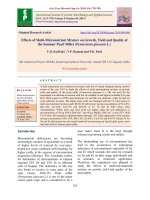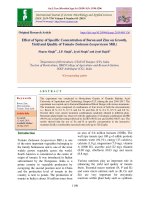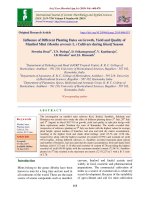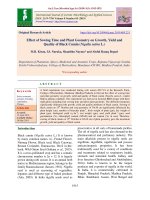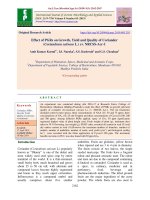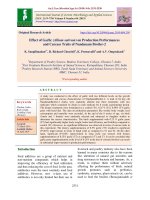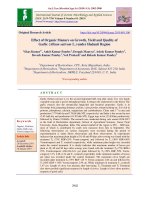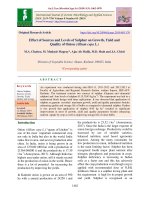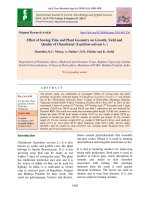Effect of organic manure on growth, yield and quality of garlic (Allium sativum L.) under Hadauti region
Bạn đang xem bản rút gọn của tài liệu. Xem và tải ngay bản đầy đủ của tài liệu tại đây (152.97 KB, 7 trang )
Int.J.Curr.Microbiol.App.Sci (2019) 8(1): 2902-2908
International Journal of Current Microbiology and Applied Sciences
ISSN: 2319-7706 Volume 8 Number 01 (2019)
Journal homepage:
Original Research Article
/>
Effect of Organic Manure on Growth, Yield and Quality of
Garlic (Allium sativum L.) under Hadauti Region
Vikas Kumar1*, Ankit Kumar Pandey2, Deepak Maurya2, Ashok Kumar Pandey3,
Devesh Kumar Pandey1, Ved Prakash6 and Rakesh Kumar Pandey2
1
2
Department of Horticulture, CPU, Kota (Rajasthan), India
Department of Horticulture, 6Department of Agronomy, BAU, Sabour-813 210, India
3
Department of Horticulture, DRMLU, Faizabad-224 001, U. P., India
*Corresponding author
ABSTRACT
Keywords
Organic, Fertilizer,
Garlic, Bulb crop,
Vermi-compost etc.
Article Info
Accepted:
20 December 2018
Available Online:
10 January 2019
Garlic (Allium sativam L.) is the second important bulb crop after onion. It is very hardy
vegetable crop and is grown throughout India. It reduces the cholesterol in the blood. The
garlic extracts also the nematicidal fungicidal and bacterial properties. Garlic is in
flavorings food, preparing chutneys, pickles, curry powder, tomato ketchup etc. It is rich in
proteins, phosphorus, calcium, magnesium and carbohydrates. China rank 1 st in area and
production (7.79 lakh ha and 179.68 lakh MT, respectively) and India is the second in area
(2.05 lakh ha) and production (10.70 lakh MT). Egypt tops in list (23.83t/ha) productivity
followed by China (23.06t/h). The research was conducted during rabi season 2016-2017
at the field of Horticulture department, School of Agricultural Sciences, Career Point
University- Kota, Rajasthan, India. The annual rainfall of the region is 650 – 1000 mm,
most of which is contributed by south west monsoon from July to September. The
following observations on various characters were recorded during the period of
experimentation is under Shoot observations and Root observations. In experiments
indicates that maximum plant height at 30, 60 and 90 days after sowing was found with the
treatment T8 (75% RDF+25% Vermi-compost) and followed by T5 (50% RDF+50%
Vermicompost) and T1 (control) respectively, while minimum plant height was recorded
under the control treatment. It is clearly indicates that maximum number of leaves per
plant at 30, 60 and 90 days after sowing were found with the treatment T8 (75% RDF+
25% Vermicompost) 4.80,4.61,6.11 per plant followed by T 5 (50% RDF 50% Vermicompost) 3.75, 4.86, 6.34 and T1 (control) respectfully while minimum number of leaves
per plant was recorded under the control treatment. The maximum clove length are
recorded under treatment T 8 (75% RDF +25 % Vermi-compost) 2.66 cm and followed by
T5 (50% RDF + 50% Vermicompost) 2.59 cm. While minimum in treatment T 1 (control)
1.67 cm. Length of clove was measure after harvesting. T 8 Treatment and T5 Treatment
also show possible significant response for length of cloves. Length of clove show positive
response of good yield.
2902
Int.J.Curr.Microbiol.App.Sci (2019) 8(1): 2902-2908
Introduction
Materials and Methods
Garlic (Allium sativam L.) is the second
important bulb crop after onion. It is very
hardy vegetable crop and is grown throughout
India. It reduces the cholesterol in the blood.
The garlic extracts also the nematicidal
fungicidal and bacterial properties. The
foliage of garlic is flattened rather than
hollow like than of the onion. Garlic contains
amino acid „Allion‟ which is colourless.
The present investigation entitled “Effect of
Organic Manure fertilizer of growth, yield
and quality of Garlic (Allium satium L.)”
under Hadauti Region‟‟ was conducted during
rabi season 2016-2017 at the field of
Horticulture
department,
School
of
Agricultural
Sciences,
Career
Point
University- Kota, Rajasthan, India. The
experiment was conducted to find out the best
IBA concentration and appropriate time of
planting for improving the rooting potentially
of cuttings, when propagated through
hardwood cuttings. This zone possesses
typically sub-tropical climatic conditions
characterized by mild winters and moderate
summers associated with high relative
humidity during the months of July to
September. The annual rainfall of the region
is 650 – 1000 mm, most of which is
contributed by south west monsoon from July
to September.
However when cloves are crushed allicin is
formed due to the enzymatic reaction of
allinase. The economic yield is obtained from
its underground herb, which is considered of
bulbets, popularly called as cloves. Garlic is
in flavorings food, preparing chutneys,
pickles, curry powder, tomato ketchup etc. It
is rich in proteins, phosphorus, calcium,
magnesium and carbohydrates. The uninjured
bulb content a colourless, odorless water
soluble amino acid allion by crushing the
garlic bulb, the enzyme alliances break down
allion to produce allicin of which the principle
ingredient is the odouriferous diallyl-disulfide
(60%) diallyl-trisulfied (20%), allylpropyl
disulfide (6%) and small quality of diethyl
disulfide and probably diallyl polysulfide.
The world production of garlic was 222.82
lakh MT, from 3.71 lakh hectare areas
(Annon.2009).china, India Republic of Korea,
Russian Fed, Myanmar Ethiopia USA and
Egypt are the major garlic growing countries.
China rank 1st in area and production (7.79
lakh ha and 179.68 lakh MT, respectively)
and India is the second in area (2.05 lakh ha)
and production (10.70 lakh MT). Egypt tops
in list (23.83t/ha) productivity followed by
China (23.06t/h). Whereas it is quit law
(5.22t/h) in India compared to world average
(16.26t/ha). Among the different state in India
Madhya Pradesh is the leading accounting for
the 27% of area and 23% of production with
average yield of 4.47 t/h.
Experimental design: Factorial Randomized
Block Design (FRBD)
Number of replications:
3
Number of cuttings per treatments: 10
Number of treatment combinations: 3x3
Total number of cuttings:
3x3x3x10=270
Experimental details
A. Time of plantings
DATE
25TH DECEMBER
10TH JANUARY
25TH JANUARY
NOTATION
T1
T2
T3
B. IBA concentration
CONDITION
500PPM
1000PPM
CONTROL
2903
NOTATION
C1
C2
C2
Int.J.Curr.Microbiol.App.Sci (2019) 8(1): 2902-2908
Treatment combinations
T1C1
T1C2
T1C3
T2C1
T2C2
T2C3
T3C1
T3C2
T3C3
Treatments
T1: Control
T2: RDF (NPK) 100%
T3: Vermi-compost 100%
T4: FYM 100%
T5:50% RDF+50% Vermicompost
T6:50% RDF+50% FYM
T7:50% Vermicompost+50% FYM
T8:75% RDF+25% Vermicompost
T9:75% RDF+25% FYM
T10:50%
RDF+25%
FYM+25%
Vermicompost
Preparation of cuttings of plants selected for
cuttings were disease free, moderately
vigorous and healthy. The cuttings were made
from healthy and partially matured shoots
having 4-5 nodes. The length of the cuttings
varied between 15-20cm (6-8 inches) and, the
diameter for hardwood cutting (1.3-1.5cm),
respectively. The cuttings were collected
early in the morning when leaves and shoots
of stock plants were turgid. The required
concentrations of growth regulator IBA (500
and 1000 ppm) was prepared by dissolving
0.5g and 1g of IBA in few ml of 80 % ethanol
and the volume was made up to one litre by
adding distilled water in 1000 ml volumetric
flasks. Quick dip method was adopted for
treatment of the cuttings with IBA solutions.
The basal portions of cuttings up to 2.5-3 cm
were soaked with solution for 10 seconds.
After 10 seconds of treatment, the cutting
were removed from the solutions and
immediately planted in the polythene bags
carefully with the help of dibbler without any
injury to the buds on December 25th, January
10th and January 25th. At the time of planting,
1/3 part of cutting was inserted in the rooting
media. Each polythene bag consists of one
cutting. The soil around the cuttings was
tightly pressed and then light watering was
given to the cuttings. The following
observations on various characters were
recorded during the period of experimentation
is under Shoot observations is taken
Percentage of sprouted cuttings, Percentage of
unsprouted cuttings, Average number of
sprouts per cutting, Length of longest
sprouts(cm), Number of leaves on new shoots
and Root observations and under Root
observations is taken Percentage of rooted
cuttings, Number of primary roots, Length of
longest roots(cm), Fresh weight of roots per
cutting(gm), Dry weight of roots per
cutting(gm). Shoot observations the following
observations of the cuttings were recorded at
15 days intervals. The number of sprouted
cutting was counted in each treatment at 10
days interval and the mean number of
sprouted cuttings was worked out. The
number of unsprouted cutting was counted in
each treatment at 10 days interval and the
mean number of unsprouted cuttings was
worked out.
The average numbers of sprouts per cutting in
each treatment at 15 days interval were
calculated and the mean average number of
sprouts per cutting was recorded. Length of
sprouts (cm) was measured with the help of
scale in each previously tacked shoots at 15
days interval and the mean length of sprouts
was found. The total numbers of leaves were
counted on newly emerged shoots of cuttings
at 15 days interval and average number of
leaves per shoots was calculated. The
following observations were taken at the end
of study period after uprooting the sprouted
cuttings. Percentage of rooted cuttings Total
number of rooted cuttings was noticed and
calculated the rooting percentage on the basis
of following formula:
2904
Int.J.Curr.Microbiol.App.Sci (2019) 8(1): 2902-2908
Percentage of rooted cuttings =
Number of rooted cuttings
x 100
Total number of cutting
Three randomly selected cuttings from each
treatment each replication was taken for
recording the data on number of primary
roots. Average number of primary roots
cutting was calculated by dividing the total
number of primary roots, with the number of
cuttings. This observation was recorded at the
termination of experiment after three months.
Length of root was measured with the help of
measuring scale and mean value was
calculated. The randomly selected cuttings
were used to measure fresh weight of roots
(gm) with the help of electronic balance. The
average fresh weight of roots was calculated
by dividing the total weight by number of
cuttings. The same samples of fresh root from
cuttings per replication were also dried for dry
weight (gm) in oven at 58± 20C, until
attaining a constant weight. The average dry
weight of roots was calculated by dividing the
total dry weight of roots with number of
cuttings. The experiment was laid out in the
Factorial Randomized Block design (FRBD)
with three replications as described by
Cochran and Cox (1992). Valid conciliations
were drawn after the analysis of data at 5
percent level of significance. Critical
difference was calculated in order to compare
the treatment means. The experimental results
are presented with the help of tables and
diagrams wherever found necessary.
Results and Discussion
The results obtained from the study on
growth, yield and quality of garlic are
discussed. The effect of the organic manure
fertilizers significantly increased the plant
height recorded in the treatment RDF and
FYM along with the vermi-compost
application. It is clearly indicates that
maximum plant height at 30, 60 and 90 days
after sowing was found with the treatment T8
(75% RDF+25% Vermi-compost) and
followed by T5 (50% RDF+50% Vermicompost) and T1 (control) respectively, while
minimum plant height was recorded under the
control treatment. It is clearly indicates that
maximum diameter of stem at 30, 60 and 90
days after sowing was found with the
treatment T8 (75% RDF+50% Vermicompost) 5.05, 6.89, 16.73cm followed by T5
(50% RDF+50% Vermicompost) 4.84, 6.23,
16.00cm and T1 (control) 3.69, 5.44, 9.62
respectively, while minimum diameter of
stem was recorded under the control
treatment. The reason for maximum diameter
of stem due to the higher concentration of soil
enzymes, soil organic matter and soil for
rapid mineralization and transformation of
plant nutrients in soil, application of RDF,
Vermi-compost nutrient resulting in increased
to the diameter of stem. The result of this
study are agreements with the Mandloi et al.,
(2008), Ali et al., (1998) Gunadi et al., (1996)
and Naidu et al., (2000) in garlic crop. It is
clearly indicates that maximum number of
leaves per plant at 30, 60 and 90 days after
sowing were found with the treatment T8
(75% RDF+25% Vermi-compost) 4.80, 4.61,
6.11 per plant followed by T5(50% RDF%
50% Vermi -compost) 3.75,4.86,6.34 and T1
(control) respectfully while minimum number
of leaves per plant was recorded under the
control treatment. The reason for maximum
number of leaves due to the higher N found in
experimental plant than control, NPK nutrient
resulting in increased to the number of leaves.
The results of this study are agreements with
the Suthar (2009), Singh et al., (1994), Setty
et al., (1989) and Kore et al., (2006) in garlic
crop. Effect of organic manure fertilizers
significantly higher leaf length recorded in the
treatment RDF along with the vermicompost
application is given. It is clearly indicates that
maximum leaf length at 30, 60 and 90 days
2905
Int.J.Curr.Microbiol.App.Sci (2019) 8(1): 2902-2908
after sowing were found with the treatmentT8
(75% RDF+25% Vermi-compost) 18.41,
30.84, 42.48cm followed by T5 (50%
RDF+50% Vermicompost) 17.67, 29.44,
41.36and T1 (control) respectively, while
minimum leaf length was recorded under the
control treatment. The reason for maximum
leaf length due to the earthworm casts
application there was an increase in number
of tillers and of leaves application of
Vermicompost with NPK nutrient resulting in
increased to the leaf length. The results of this
study are agreements with the Singh et al.,
(1994) and Naidu et al., (2000) in garlic crop.
It is clearly indicates that maximum leaf
width at 30, 60 and days after sowing were
found with the treatment T8 (75% RDF+25%
Vermi-compost) 0.57, 0.97, 1.77 mm
followed by T5 (50% RDF + 50%
Vermicompost) 0.53, 0.95, 1.60 and T1
(control) 0.34, 0.79, 1.06 respectively, while
minimum leaf width was recorded under the
control treatment. The reason for maximum
leaf width because in the form of traditional
inorganic NPK and in the form of Vermicompost, brings an excellent biochemical
changes in soil structure, which ultimately
promotes plant growth. The results of this
study are agreements with the Naidu et al.,
(2000) and Suthar (2009). Effect of organic
manure fertilizers significantly higher plant
height recorded in the treatment RDF along
with the vermin-compost application was
given. It is clearly indicates that maximum
weight of bulb at harvesting time was found
with the T8 (75%RDF+25%Vermicompost)
48.47g followed by T5 (75%RDF + 25%
Vermicompost) 47.41gand T1 (control) 32.97g
respectively, while minimum weight of bulb
was recorded under the control treatment. The
reason for maximum weight of bulb due to
the RDF and Vermi-compost application in
the soil enhances the biochemical potential of
soil and consequently effect plant production.
The results of this study are agreements with
the Suther (2009), Jahangiret al., (2005) and
Abdel et al., (2002) in garlic crop. It is clearly
indicates that maximum diameter of bulb at
harvesting time was found with the treatment
T8 (75%RDF+25% Vermicompost) 5.45cm
fallowed by T5 (50%RDF+50% Vermicompost) 5.26cm and T1 (control) 3.84cm
respectively, while minimum diameter of bulb
was recorded under the control treatment. The
probable reason for maximum diameter of
bulb is may be due to the application of RDF
which enhanced the activity of some
microbial population vermin-compost along
with NPK nutrient resulting in increase to the
diameter of bulb. The results of this study are
agreements with the Bhati et al., (2002),
Verma et al., (1996) and Yadav (2003) in
garlic crop. Effect of organic manure fertilizer
significantly higher number of cloves per bulb
at harvesting time was recorded in the
treatment RDF along with the vermincompost application was given. It is clearly
indicates that maximum number of cloves per
bulb at harvesting time were found with the
treatment T8 (75% RDF + 25%
Vermicompost) 40.05/bulb fallowed by T5
(50% RDF + 50% vermicompost) 39.09/bulb
and T1 (control) 25.75/bulb respectively,
while minimum number of cloves per bulb
was recorded under the control treatment.
Application of RDF and vermicompost,
nutrient resulting in increase of cloves
number per bulb. The results of this study are
agreements with the Yadav (2003), Reddy et
al., (2000), Ali et al., (1998) and Verma et al.,
(1996) in garlic crop. Effect of organic
manure fertilizers significantly maximum
yield q/ha were recorded in the treatment
RDF along with the vermicompost application
was given. It is clearly indicates that
maximum yield q/ha was found with the
treatment T8 (75% RDF + 25 % Vermicompost) 310.66q/ha fallowed by T5 (50%
RDF + 50% Vermicompost) 284.32q/hand T1
(control) 250.00q/ha respectively, while
minimum yield q/ha was recorded under the
control treatment. The application of RDF and
2906
Int.J.Curr.Microbiol.App.Sci (2019) 8(1): 2902-2908
vermin-compost, and micro nutrients setting
are affected the soil ability and balancing
nutrient supply to the plant increase with the
result with the study are agreement with the
findings of Yadav (2003), Patil et al., (2007),
Sharma (1988), Singh et al., (1994) and
Jahangir et al., (2005) in garlic crop. The
maximum clove length are recorded under
treatment T8 (75% RDF + 25%
Vermicompost) 2.66 cm and followed by T5
(50% RDF + 50% Vermicompost) 2.59 cm.
While minimum in treatment T1 (control) 1.67
cm. Length of clove was measure after
harvesting. T8 Treatment and T5Treatment
also show possible significant response for
length of cloves. Length of clove show
positive response of good yield. The
maximum neck thickness of bulb recorded in
treatment T8 (75% RDF + 25%
Vermicompost) 1.50 cm and Followed by T5
(50% RDF + 50% Vermicopost) 1.40 cm and
the lowest is the T1 (control) 1.02cm T8
treatment is perfect compared to other
treatment combination. The maximum
number of bulb/kg was recorded in treatment
T8 (75% RDF + 50% Vermicompost) 48.74
bulb/kg and followed by T5 (50% RDF + 50%
Vermicompost) 39.10 bulb/kg. While
minimum in control treatment T1 (control)
34.74 bulb/kg.
Summary and conclusion of the study are as
follows:
Regarding growth parameter mainly plant
height, Number of leave/plant, Length of
leave/plant, Width of leave, Diameter of stem,
Diameter of bulb, Number of clove/bulb,
Length of clove/bulb, Neck Thickness of
bulb, Weight of bulb (g), Number of bulb/kg,
Yield of bulb q/ha. The RDF, Vermi-compost
and FYM manure and fertilizer along with
some combination was applied in the field
crop of the garlic to test its importance of
plant growth and productivity. There was
excellent plant growth as well as yield quality
in garlic plants that received vermin-compost
as nutrient supplier in field. The result
indicated the advantage of vermin-compost in
such field crop production, but here such
effect could be attributed to the nutritional
status of vermin-compost and to a variety of
other factor (soil microbial structure and
activity, mineralization and soil enzymatic
factors). The data clearly indicates that
vermin compost may be an efficient plant
growth media for sustainable plant
production, if applied with some combination
RDF.
Therefore it may be concluded on the basis of
above investigation that the combination of
organic manure and inorganic fertilizer i.e.
treatment T8 (75% RDF+25% Vermicompost)
can be recommended for garlic growers to
achieve the better growth, higher and
qualitative yield under the Hadauti Region of
Rajasthan.
References
Alam, M.D., Rahim, M.A. and Sultana, M.S.
1999. Effect of paclobutrazole and
sulphure fertilizer on the growth and
yield of Garlic. Bangladesh Journal of
Training and Development, 12(1-2):
223-230.
Alkaff, H. A., Saeed, O. S. and Salim, A. Z.,
2002. Effect of biofertilizer, inorganic,
organic and foliar application of Power
4 on the productivity of onion. Univ.
Aden J. Natural and Appl. Sci., 6(1): 114.
Bhatia, A. K. and Pandey, U. C., 1991. Effect
of planting methods, fertility levels and
spacing on seed production of kharif
onion. Res. Dev. Rep., 8(1): 10-16.
Devi, A. K. B., Limi Ado, and Singh, N. G.,
2003. Effects of inorganic and
biofertilizers on bulb yield and
economics of multiplier onion (Allium
cepa L. var. aggregatum Don). News
2907
Int.J.Curr.Microbiol.App.Sci (2019) 8(1): 2902-2908
Lett Nation, Hortic. Res. and Dev.
Found., 23(3): 13.
Moon, W. and Lee, B.Y. 1980. J. Korean Soc.
Hort. Sci., 21:109-18.
NHRDF, 2007-2008. State wise area,
production and productivity data for
Garlic.
Pandey, U.B. and Singh, D.K. (1993).
Response of Garlic to different levels of
irrigation and nitrogen. News LetterNational Horticultural Research and
Development Foundation. 13:3/4, 1012.
Resende, G.M. and Souza R.J. 2001.
Influence of nitrogen rates and
application time over yield and
commercial characteristics of Garlic.
Horticultura Brasileira. 192, 126-129.
Warade, S. D., Desale, S. B. and Shinde, K.
G., 1996. Effects of organic, inorganic
and biofertilizers on yield of onion
bulbs cv. B 780. J. Maharashtra Agric.
Univ., 20(3): 467 468.
William G. Cochran, Gertrude M. Cox,
Experimental Designs, 2nd Edition,
May 1992. 640 Pp.
Yadav, P. K. 2003. Effect of nitrogen and
potassium on growth and yield of Garlic
(Allium sativum L.) in western
Rajasthan.
Haryana
Journal
of
Horticultural Sciences 32: ¾, 290-291.
How to cite this article:
Vikas Kumar, Ankit Kumar Pandey, Deepak Maurya, Ashok Kumar Pandey, Devesh Kumar
Pandey, Ved Prakash and Rakesh Kumar Pandey. 2019. Effect of Organic Manure on Growth,
Yield and Quality of Garlic (Allium sativum L.) under Hadauti Region.
Int.J.Curr.Microbiol.App.Sci. 8(01): 2902-2908. doi: />
2908

